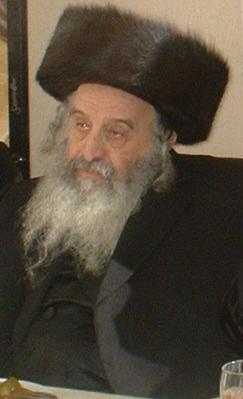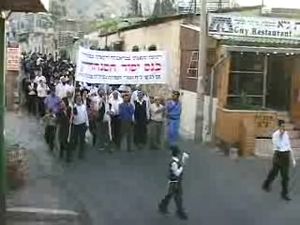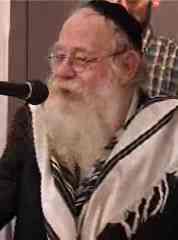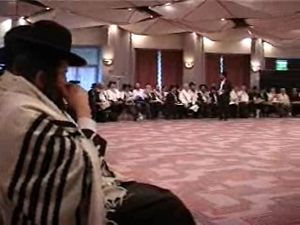The Nascent Sanhedrin
The current attempt to re-institute semicha and re-establish a Sanhedrin is the the sixth attempt in the last five hundred years, but unlike previous attempts, for the first time there seems to be wide consensus among the leading Torah sages living in the Land of Israel for the pressing need for such an institution at this time. Rabbi Dov Levanoni explained the steps leading up to the most recent attempt to renew the institution of semichah in 2004, through a consensus of hundreds of the most influential and scholarly Rabbis living in the Land of Israel. Rabbi Yaakov Beirav and Rabbi Yosef Karo laid an excellent halachic foundation for understanding this teaching of Maimonides, the current attempt to re-establish the Jewish Sanhedrin has tried to learn from previous attempts and avoid some of the pitfalls.
Contents
The election process and selection of Rav Halberstam
Maimonides and other medieval commentators suggested that, although the line of semicha (Biblical ordination) from Moses had been broken in 425 C.E., if the sages in the land of Israel agree upon a single candidate being worthy of semicha, that individual would have semicha, and could then grant it to others, thus enabling the re-establishment of the Sanhedrin
The process of election was explained by Rabbi Dov Levanoni, a member of the new Sanhedrin. He said the most recent attempt to renew the institution of semicha in 2004, was made through a consensus of hundreds of the most influential and scholarly Rabbis living in the Land of Israel. While Rabbi Yaakov Beirav and Rabbi Yosef Karo laid an excellent halachic (Jewish law) foundation for understanding this teaching of Maimonides, the current attempt to re-establish the Jewish Sanhedrin has tried to learn from previous attempts and avoid some of the pitfalls. For example, to avoid claims that not all the rabbis of Israel were aware of the latest attempt to set up the Sanhedrin, an initial enormous expenditure was spent on a publicity campaign of the upcoming semichah process, 50,000 copies of a detailed flier were distributed among 4,500 Jewish centers in Israel, outlining that a vote of a first samuch was going to be held, along with contact information of the Va'ad ha-Mechonen la-Sanhedrin. Not long afterwards, seven hundred leading Rabbonim were contacted either in person or by written letter. R' Levanoni explained that Rabbi Moshe Halberstam, a senior Rabbi on Jerusalem's Edah HaChareidis, became the first samuch after receiving approval by Israel's leading rabbis – those followed by most of Israel's religious Jews – and there were no objections from the hundreds of rabbis consulted via written letters.
Leading sages have supported the semichah directly, indirectly or abstained, and specifically mentions these names: Rabbi Yosef Shalom Eliashiv, Rabbi Ovadia Yosef, Rabbi Zalman Nechemia Goldberg and many others gave their blessing but did not join the Sanhedrin. The son of Rabbi Mordecai Eliyahu is one of the rabbis ordained. Former Ashkenazi Chief Rabbi and Rosh Yeshiva of Merkaz HaRav Kook Rabbi Avraham Shapira chose to abstain on the issue but also refused to discourage it.
Rabbi Moshe Halberstam (April 1, 1932 –April 26, 2006), who was selected to receive Semicha by consensus, was a relatively well known figure and widely respected. Rabbi Halberstam was the son of Grand Rabbi Yaakov Halberstam of Tshokava (a scion of the Sanz (Hasidic dynasty) dynasty) and the daughter of Rabbi Sholom of Shotz (Hasidic dynasty) of London. He was the rosh yeshiva of the Tshokava Yeshiva in Jerusalem and one of the most prominent members of the Edah Charedis Rabbinical court of Jerusalem. He was known as a tremendous Torah scholar and a decisor of Halachah law. He wrote approbations to many works of Torah literature. Rabbi Halberstam served at the President of Hatzolah Israel. He was also the Rabbi of the Shaarei Tzedek Hospital in Jerusalem. He was known for his tolerance towards other streams of thought in Orthodox Judaism. Despite his own Chareidi anti-Zionist background, he also maintained contacts with Modern Orthodox, religious Zionist leaders.
These figures did not necessarily supported the creation of a Sanhedrin, only that they supported the reinstitution of Semicha. Rabbi Dov Shtein, the secretary for the Sanhedrin project, said that Rabbi Moshe Halberstam understood the where his actions would lead. Rabbi Dov Shtein said "Without Rabbi Halberstam's efforts toward renewing semikha, it would not have happened the way it did," he said. "By agreeing to be the first to be ordained, he took a serious risk of being rejected and condemned by his community for taking part in such a project, which set the ball rolling for the foundation of a Jewish legal body that seeks to eventually supersede the Badatz. But despite the serious pressures put on him following his agreement and granting of semikha to others, he never went back on it or even tempered his agreement with the act of renewing semikha."[1].
The formation of a placeholder Sanhedrin
To avoid disagreements over who was worthy to sit on the Sanhedrin, a Beis din of 71 was immediately formed. It was formed with the best scholars available, with the public announcement every one of them has agreed to step aside the moment a more deserving candidate should step forward. Lastly, the Nasi has indicated that the Beis din would wait until the best scholars of Eretz Yisroel were represented on the Beis din before beginning to fully function halachically as the Sanhedrin of old.
In October 2004, a group of over few hundred rabbis representing varied communities in Israel undertook a ceremony in Tiberias, where the original Sanhedrin was disbanded, with about one hundred of them at time having proper Semicha. This was one year after the re-establishment of Semicha. A Beth Din of 71 was formed.
Rabbi Tzvi Eidan, the author of Asot Mishpat (on the laws of reestablishing the Sanhedrin) was appointed as first interim Nasi. Rabbi Adin Steinzaltz, a noted Talmudic scholar and a well-known Jewish philosopher is the currently elected Nasi. The Sanhedrin's spokesmen said that due to concerns that external pressure would be brought to bear upon individuals not to take part in the establishment of a Sanhedrin, the names of most participants would not be made public.
Some of its more known members included[2]
- Rabbi Adin Steinsaltz, a well known Talmudic scholar who began translating and commentating on the Talmud in 1965, established a network of schools in Israel and Russia, and has received honorary degrees from Yeshiva University, Bar Ilan University, Ben Gurion University and Florida International University
- Rabbi Nachman Kahane, a graduate of Mir (Jerusalem), a rabbinic scholar and the rabbi of the Young Israel of Jerusalem's Old City. He is currently working on an interpretation of the Tosafot of the Talmud. He is also the director of the Institute for Talmudic Commentaries and has created a database of reliable Kohen in Israel.
- Rabbi Yoel Schwartz, a graduate of Ponevezh yeshiva in Bnei Brak and Mir yeshiva in Jerusalem, and was the mashgiach, the spiritual supervisor, of Yeshivat Itri and of the Nahal Charedi religious army program. He is a well known Torah scholar and a prolific writer who has published over 200 Jewish books.
- Rabbi Dov Levanoni, a Holocaust survivor, a prolific author and the author of Hamikdash, a description and model of the Second Temple according to Maimonides and other opinions.
- Rabbi Yisrael Ariel is the founder of the Temple Institute (Machon HaMikdash), which focuses on preparations for the rebuilding of the Third Temple. As a young man, he served in the paratroop unit that liberated the Western Wall (kotel) in the Six-Day War.
- Rabbi Yehuda Edri is a Torah scholar, supervisor and principal for the Chareidi Shas Party's El Hamaayan Educational system. He is an expert on the location of the Temple and its measurements.
The acceptance of office of Nasi by Rabbi Steinsaltz
On the other hand, apparently few Sanhedrin members see the nascent Sanhedrin with such an extreme messianism. The acceptance of office of Nasi by Rabbi Adin Steinsaltz was marked with an apparent change in direction.
The newspaper Haaretz reported:[3]
In his speech accepting the position of Nasi, Rabbi Adin Steinsaltz said that the task of building the Sanhedrin will take some time. He spoke about gradually building up the ancient institution, which would take several generations. "In order to move forward and no longer be defined as `an aborted fetus,' to become serious so we can say, `a child was born to us,' we need a lot of time. The mere mention of the name Sanhedrin is not a given. It is no longer a matter of a religious council... It's something that has historical meaning. A basic change, not of one small system, but of fundamental systems."
"It's no wonder that these things frighten people. There are people who are concerned about what is emerging here. And where is it headed? After we have made it through this year with no catastrophes occurring, even though there were some foolish comments and chuckling, we will intensify and strengthen our activities. We will do things with an eye toward future generations, not with a stopwatch and an annual calendar. The Jewish calendar is a calendar of thousands of years. A lot of patience and a lot of work are needed. I'd be happy if in another few years these chairs are filled by scholars who are greater than us and we can say: `I kept the chairs warm for you.'"
Steinsaltz used his position as president of the Sanhedrin to protest its involvement in politics. "I'm not afraid of the Supreme Court, the police or the attorney general. A rabbi is also permitted to engage in public issues, but to do so he has to have all the appropriate material before him, whether he is dealing with the kosher status of a chicken or the disengagement".
Under the influence of Rabbi Steinsaltz, the Sanhedrin project shifted away from idealistic projects of its first year and tried to move toward broadening participation. Steinsaltz requested that the new Sanhedrin not be referred to as "the Sanhedrin", but requested modest references to the current institution as the nascent Sanhedrin, the developing Sanhedrin, the Sanhedrin project, or simply the Rabbinical Court of 71 judges (Beis din shel 71). Steinsaltz is reportedly changing the direction of the new Sanhedrin, widening the scope and acceptance of the Court with the intention of moving towards becoming the full Sanhedrin.[4]
The strategy to gain wider acceptance and "provide a smooth transition from current halachic leadership to a full Sanhedrin", is to follow these guidelines: Absolute adherence to traditional Rabbinic authorities and procedure; Caution and conservatism; Independence from any other organization; Scholarship; and an open dialog with the Torah sages and current halachic leadership (with the eventual goal of their participation). On their forum it was put this way, "the [new] Sanhedrin should hold no surprises. It should be as comfortable as opening a gemoro [Talmud] or as familiar as reading the Shulchan aruch. It should be the embodiment of Judaism as we know it today."[5]
The current Sanhedrin's view of government
The Sanhedrin is a form of Rabbinic Parliament, part of a bicameral system that reflects traditional Jewish government.[6] This model has influenced the organizational structure of many Western European legislatures.[7] They describe the roles of an upper and lower house:
- The Sanhedrin is described as a "House of Scholars". This body represents the "rights and obligations" of the people to the "Torah Constitution" which they define as including "the Torah, Talmud and body of Rabbinic Jurisprudence that has been built up over our history as a people".[8]
- A parallel "Congressional Assembly" represents the "democratic needs of the population". It is conceived as being derived from the royal court of a constitutional monarchy, in a democratic society it would consist of an assembly of regionally elected representatives, represented by voting power.[9] (The head of the lower house was traditionally the Monarch, or in a modern times a Prime Minister. He would have the power to collect taxes and would be the head of the executive branch of government. He would be subordinate only to the Sanhedrin[10])
The Sanhedrin would function as an equal legislative body to a democratically elected body, but it would also function as a supreme judicial body with regard to interpreting basic law, or what they call a "Torah Constitution". It would be analogous to combining the Supreme Court of the United States and United States Senate into one legislative house, and has some similarity to the role of upper houses such as the Canadian Senate, designed to act as an unintended "sober second thought", and the British House of Lords, which cumulates legislative and judicial functions. It appears that this structure in the Sanhedrin context implies a democracy functioning within a Torah Constitution. From an Israeli point of view this implies adding a second house to Knesset and declaring a Basic Laws of Israel requiring Israeli civil law to function within halakha.
Torah Constitution
This agenda requires a focus on efforts to institute a theocracy or critocracy system of government in which "the authority of government depends on Jewish law",[11] so that secular government institutions and laws would be subordinate to, and function within, halakha as determined by the Sanhedrin. The Sanhedrin has declared itself to have authority to veto democratically-enacted laws which it determines are contrary to the laws of Torah. (This is analogous, for example, to the U.S. Supreme Court's ability to nullify a state law mandating segregated school systems for minorities as contrary to the Constitution). It has made this very clear in, among other pronouncements, its "Decision of the Sanhedrin concerning the State Elections". The Sanhedrin announced that it is seeking a state in which any matters contrary to what Jewish law defines are "issues that cannot be decided by vote":
Torah "Basic Law": Laws which are contrary to the laws of the Torah are not laws of the Jewish people, and therefore they are invalid. Any law which is contrary to the laws of Torah, legislated by the "Knesset" (including legislated amendments) or interpreted as such by judicial sources is a disqualified law. The authority to decide in these matters has been unconditionally expropriated by the central religious court based on the Torah (Bible) [the Sanhedrin].[12]
In exercising its authority over "matters concerning the Land of Israel", the Sanhedrin has issued a series of decisions declaring the Israeli pullout from Gaza invalid. In "The Sanhedrin's Declaration Concerning the Disengagement from Gaza",[13] the Sanhedrin prohibited Jews from cooperating with the Government, saying: "The Prime Minister's program of uprooting stands in direct contradiction to the Torah of Israel.", "the decision of this government...is null and void.", "No Jew is permitted to cooperate" and "Any Jew - including a soldier or policeman - who supports the uprooting...transgresses a large number of Torah commandments."
Commenting on the 2006 Israel-Lebanon conflict in August 2006, the new Sanhedrin being the only authorized national institution to deal with the legal aspects of warfare and to give policy directives to the State concerning warfare. Enacting legislation concerning warfare always has been a distinguishing feature of the historical Sanhedrin.[14]
The Sanhedrin's actions
A great deal of discussion on the Sanhedrin forum appears to indicate that the new Sanhedrin is currently taken up with philosophical discussions about the theory of Jewish Law. The point is repeatedly made that the Sanhedrin "must solve many complex halachic issues" before it can begin to make any statement or decision in terms of Jewish law.[15] Its projects are "coordinated in complete consultation with the Gedolei Hador (leading halachic authorities of the generation) as well as with the Israeli Government Authorities, academics and professionals.... The Sanhedrin Initiative seeks to empower Jews to perform national mitzvot that thanks to technological advances and/or sociological developments are currently or imminently in the realm of the possible. The Initiative is staffed by accomplished scholars and academics striving to promote dignified Jewish freedom of religious expression which is consistent with the values of Western democracy. The Sanhedrin Initiative adheres to the criteria of halacha (Jewish law), expertise, amenity and peace in... all its... projects."[16] The Hebrew version adds that it "has no connection with extremist groups, right wing political parties, or those who disregard Jewish law."[17] Events as portrayed by the media, however, have not always fit this idealic picture:
- The new Sanhedrin formed a committee to collect opinions as to the exact location of the Temple on Temple Mount.[18]
- Some of its members ascended to a portion of the Temple mount[19] that was added by Herod and is considered permitted to Jews according to some opinions.[20]
- This visit culminated in a declaration that the "Jewish people should begin collecting supplies for the rebuilding of the Temple".[21]
- They have announced ties with various academic scholars and institutions.[22]
- They issued religious rulings on the formulation of the Rachem prayer for Tisha B'Av services, the kashrut of pheasant and quail, and the proper formulation of the Birkat HaMazon (grace after meals).[23]
- There was dialogue with the Ministry of Education over "the Bible and Scriptures curriculum".[24]
- They support Jewish settlement of the West Bank and opposed the Gaza withdrawal.[25]
- An Israeli court allowed a defendant to consult a ruling from a subordinate court of the Sanhedrin.[26]
- Since February 2006, the nascent Sanhedrin has been represented on the Internet by the 'Friends of the Sanhedrin'.
- They supported religious and far right parties in the Israeli legislative election, 2006.[27]
- During the Lebanon War they offered extensive opinions in the area of war and military policy.[28]
- They opposed the Gay Pride parade in Jerusalem in September 2006 (which was canceled), declaring participation in the security operations for the parade a criminal act.[29]
- They issued repeated calls for soldiers and policemen to disobey orders that the nascent Sanhedrin regards as contrary to Halakha.[30]
- They blew the shofar on Rosh Hashanah in September 2006, which fell on a Shabbat. This was essentially a claim to the rights and authority of a true Sanhedrin.[31][32]
- Summoned an IDF officer who issued restraining orders for several residents of the West Bank to appear before the nascent Sanhedrin. This resulted in a Police investigation of the Rabbis who issued the summons.[33][34] However the reaction of the new Sanhedrin was defiant.[35]
- Their annual public conference in 2007 included calls for the public to support a government based on Jewish Law.[36]
- For Passover 2007, they led a drive to offer the passover sacrifice on the Temple Mount.[37][38]
- In May 2007, they launched a diplomatic peace initiative aimed at averting a conflict between Israel and Iran, and resolving the issue of the Temple Mount.[39][40]
- In August 2007, At the request of the Falun Gong, the new Sanhedrin was to deliberate persecution of the movement by Chinese regime.[41][42][43]
- In October 2007, several members of the new Sanhedrin ascended to the Temple Mount and began saying short prayers on the mount, with the apparent support of the Israeli government.[44][45]
- In January 2008, they wrote a letter to U.S. President George W. Bush during his visit to Israel requesting that he not divide Jerusalem.[46][47] The letter was delivered by former Sephardic Chief Rabbi, Rabbi Mordechai Eliyahu.[48]
Source: Wikipedia
Legal rulings
- Main article Legal rulings and opinions to date
References
- ↑ Jerusalem Post: Rav Moshe Halberstam, First to Renew Semicha, Dies at 74
- ↑ Current members of the Sanhedrin
- ↑ Haaretz
- ↑ Arutz-7: Sanhedrin Project Unveiled With Humility
- ↑ Sanhedrin Forum
- ↑ Special Court For Matters Concerning The Nation and the State
- ↑ ibid. Examples are given concerning division of authority, the name "Senate", even semi-circle seating.
- ↑ Sanhedrin Forum
- ↑ Special Court For Matters Concerning The Nation and the State
- ↑ ibid.
- ↑ http://www.thesanhedrin.org/en/press/hatzofe20032006.html Sanhedrin, "The Authority of the Government Depends on Jewish Law"
- ↑ Sanhedrin, "Decision of the Sanhedrin concerning the State Elections"
- ↑ [1]<"The Sanhedrin's Declaration Concerning the Disengagement from Gaza"
- ↑ Concerning responding to an attack
- ↑ Haaretz
- ↑ About KorbanPesach.org
- ↑ hebrew version About KorbanPesach.org (he)
- ↑ Decision of the Sanhedrin concerning the exact location of the Temple on the Temple Mount
- ↑ Israel National News: Members of Reestablished Sanhedrin Ascend Temple Mount
- ↑ Temple mount#Jewish see also 'The debate stirred within the Haredi camp' below.
- ↑ The Temple Institute: The Sanhedrin's Decision Regarding the Holy Temple, the Temple Mount, and Jerusalem
- ↑ Issues on the agenda to be discussed a future sessions
- ↑ Sanhedrin, Legal Rulings and Opinions to Date
- ↑ Haaretz
- ↑ The Sanhedrin's Declaration concerning the disengagement from Gaza
- ↑ Israel National News: Sanhedrin Project Unveiled With Humility
- ↑ Concerning the upcoming State Elections
- ↑ Based on the Mishnah's statement "they may not send forth (the people) to a Milchemet Reshut (non-mandatory war) except by order of the court of seventy-one",Mishnah Sanhedrin (Talmud) 1:5 the new Sanhedrin has declared that it is "the authorized institution to decide in matters of military policy, issues definitive moral guidance to soldiers on active duty and in the reserves.
- ↑ Legal decision concerning police officers who are called to perform their duties for the "Parade of Abomination"
- ↑ Should military call-up orders be heeded for the war in Lebanon?
- ↑ [http://www.thesanhedrin.org/he/legal/psak5767Tishrei3.html Blowing the Shofer on Shabbat by a Beit Din of Semuchim]
- ↑ 101 Years later, again the Shofar is blown on Shabbat
- ↑ Rabbi Ariel Arrested, Released - Inside Israel - Israel News - Arutz Sheva
- ↑ [2]
- ↑ [3].
- ↑ Public Conference with Rabbis of the Sanhedrin
- ↑ Jews Revive the Sanhedrin with Plans for a Passover Sacrifice
- ↑ Take Part in the (Sanhedrin's) Preparations for the Korban Pesach
- ↑ Nfc: Praying for the Temple Mount
- ↑ Ynet: The Sanhedrin’s peace initiative
- ↑ YNet: Self-appointed Torah court takes on China
- ↑ Israel National News: Sanhedrin May Hear Complaint against Chinese Torture
- ↑ NFC: International Court of Justice, according to the laws of the torah
- ↑ Israel National News: Priestly Blessing on Temple Mount
- ↑ Israel Today: Rabbis recite priestly blessing atop Temple Mount
- ↑ Arutz-7: Scroll to Mr. Bush Reminds Him of His Historic Role
- ↑ YNet: Sanhedrin to Bush: Declare that Israel belongs to Jews
- ↑ Arutz-7: Rabbi M. Eliyahu Warns Bush: Jews Never Forget
Videos
- Sanhedrin Announcement Ceremony
- Kenes HaSanhedrin 5767 Nasi Rav Even-Yisrael part 1 2 3 4 5 6
- Kenes HaSanhedrin 5767 Rav Dov Shtein part 1 2 3 4 5
- Kenes HaSanhedrin 5767 Rav Avichai Rahimi part 1 2 3 4 5
- Kenes HaSanhedrin 5767 Rav Menachem Furman part 1 2 3 4
- Kenes HaSanhedrin 5767 Moshe Feiglin part 1 2
- Kenes HaSanhedrin 5767 Dr Milshtein part 1 2 3 4
- Megillat Bush - The Bush Scroll Rabbi Chaim Richman
- Audio: Israeli Courts Recognizing the Sanhedrin? Arutz-7 (03/16/08)
External links
- Sanhedrin Conference 2007 - 29 videos from speakers at the 2007 annual conference.
- Take Part in the (Sanhedrin's) Preparations for the Korban Pesach
- Public Conference with Rabbis of the Sanhedrin
- Arutz-7: Sanhedrin reconstituted (Israel National News)
- Arutz-7: Rabbi Adin Even-Israel Steinsaltz Elected to Head Sanhedrin (Israel National News)
- Arutz-7: Sanhedrin Moves to Establish Council For Noahides (Israel National News)
- Plan To Revive Biblical Sanhedrin Receives Boost (Forward NY)
- Semicha and Sanhedrin Controversies of the 16th and 21st Centuries by Rabbi Yirmiyohu Kaganoff (against the new Sanhedrin)
- The Sanhedrin Reestablished - Jewish Press, Part I Part II Part III
In the news
- Main article Sanhedrin in the News



